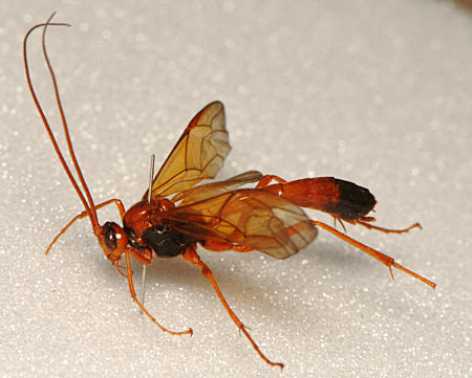 |
| Copryright © Andy Purcell. www.Focusonwildlife.org.uk |
PARASITIC INCHNEUMONOID WASPS IN LIGHT TRAPS
An Introductory Evening on Wednesday 12th November 2003
Mike Bloxham
 |
| Copryright © Andy Purcell. www.Focusonwildlife.org.uk |
Thanks to Rosemary Winnall, we were able to hold this meeting at the Wyre Forest Discovery Centre. Dave Barnett, Harry Green, John Meiklejohn, Jeff Rush, Geoff Trevis and Rosemary herself were the first to undergo this initiation and all had brought specimens. Unfortunately it is necessary to warn anyone dealing with ichneumonids that a good deal of heartache awaits them. Firstly we learned that a number of people operating light traps had been stung by some of these parasitoids - depressing news indeed. Worse was to come because, although many of the offending insects were set out before us, the chances of naming many of the guilty parties were slim!
That having been said, everyone pitched in and worked on a small group of the larger and more readily identifiable insects. This enabled appreciation of the ‘jizz’ of certain genera as well as an ability to tell an occipital carina from a scutellar lateral one. One of the unfortunate features of an evening workshop is that time flies and as a consequence, we closed having had but a tantalising glimpse of this fascinating group.
The evening also involved us in some discussion on the merits of setting up a Worcestershire recording scheme for these insects. Readers will be aware that moth trapping at light has been a regular feature in the county for a number of years and this is set to continue, with recorders such as Dr. Tony Simpson having had an additional interest in parasitic hymenoptera on a regular basis. In this context it seems that a scheme of some sort is perfectly practicable because the insects involved are readily obtained at these traps. At the above meeting Jeff Rush (Lepidopterist from the light trapping group) showed a collection of nearly two hundred taken at fourteen recent events. These included the spectacular Opheletes glaucopterus (a parasitoid of sawflies- Cimbex sp- from Shrawley Woods on September 11th 2003). It is a great pity that parasitic nocturnal ichneumonoids such as this, with wingspans in excess of 4 cm, should be so unfamiliar to students of British Natural History.
In the end the success of a scheme is always dependent on a small group of enthusiasts being prepared to do some regular hard work for a short period each year. In this case assembly of well-documented specimens will be a priority, with extraction of data through identification coming second as members are gradually trained to ‘identify the identifiable’. The scheme, if we are able to launch it, will also have benefits for other recorders (Jeff’s collection included the largest British caddis Phryganea grandis, the giant lacewing Osmylus fulvicephalus, with the Awl Fly Xylophagus ater being recorded from Ribbesford woods). I am prepared to assist in the process of setting up a recording scheme if we can get a few others to participate. Participants need to have had some experience in identification of insects but don’t have to be specialists in Hymenoptera. Initial training is likely to involve recognition of a select band of some 100 insects. The work can have considerable on-going interest as it is able to further examine the phenomenon of the attraction of insects to light traps in Worcestershire and hopefully in the course of time enable a contribution to science here.
| WBRC Home | Worcs Record Listing by Issue | Worcs Record Listing by Subject |